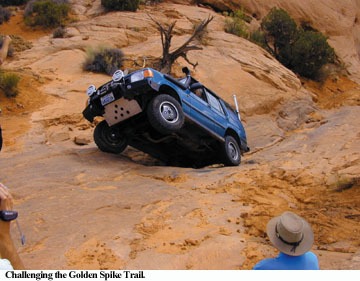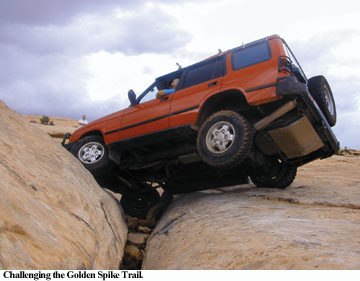 By Brooks Stevenson
By Brooks Stevenson
I never thought I would spend 13 hours in a car and travel only 18 miles. But this was no ordinary trip. Usually car rides don’t involve 4-foot crevasses, narrow rock passages, deep fissures in the sandstone and vertical slickrock steps.
But what else did I expect from one of the most famous four-wheel-drive trails in southern Utah, the Golden Spike Trail?
As a mountain biker who has visited Moab countless times, I’ve frequently shared trails with off-road vehicles. I’ve watched as they crawled like tiny insects, struggling over rocks that I could scale on a bike in no time. I’d shake my head as they spent hours on obstacles that appeared to create an unlikely impasse.
But overcoming unlikely impasses is exactly what trails like the Golden Spike are all about. Off-road trails are created to get you to places you wouldn’t normally see, overcome obstacles that logically shouldn’t be surpassed and find places to test the limits of your off-road vehicle.
 I wanted to experience all of these things so that I could better understand the passion for the sport. I wanted to have my teeth jarred loose and feel my stomach drop. I wanted to sit on a mesa, turn in every direction and see more than I’d seen at any one time before. I wanted to know I’d been to one of the most beautifully rugged places and captured every moment through my own eyes.
I wanted to experience all of these things so that I could better understand the passion for the sport. I wanted to have my teeth jarred loose and feel my stomach drop. I wanted to sit on a mesa, turn in every direction and see more than I’d seen at any one time before. I wanted to know I’d been to one of the most beautifully rugged places and captured every moment through my own eyes.
That’s why I went to the Golden Spike Trail. And what I found was more than I’d ever expected.
I’d planned my trip with a local guide named Dan Mick, who knows every inch of the trail better than his own backyard. He’s rugged, yet easygoing and amiable. His deep, honest voice and laugh are comforting to someone new to the world of four-wheeling.
Dan was taking a group of Land Rover Discoveries and their owners from San Diego, Calif., on the Golden Spike Trail, located a few miles northwest of Moab, and I was riding shotgun. The Golden Spike rattles the bones of thousands of visitors each year, and I was next in line.
Excitement wasn’t quite the word I would use for my pre-trip feelings. It was more like the apprehension you feel when you’re going into the unknown. Maybe it was just the fact that Dan had parts of his Jeep tied together with red bungee cord.
Whatever the genesis of my feelings were, I just wanted to get on the trail and begin to understand why so many people flocked to Moab each year to drive these Jeep trails.
We bounced out of Moab and past several petroglyphs, etched high upon the canyon walls. Finally we were off of the smooth, black asphalt and onto the characteristic red clay of southern Utah. The bumps and jolts began to loosen my uneasy disposition until I settled comfortably into my seat.
The trail
Dan Mick pioneered the Golden Spike Trail in 1989, during the annual Jeep Safari in Moab.
Dan had traveled both ends of the trail many times before. The route begins at the Poison Spider Mesa Trail and ends at the Gold Bar Rim Trail. It was the section in between that was of interest to Dan and his fellow off-road cronies.
So Dan started asking questions about the area. He asked the cattlemen who’d chased their herds on top of the mesa for years. He talked with friends who knew the area well, and he drew on his own understanding of the landscape to decide a route was indeed conceivable.
Dan set out from Poison Spider Mesa and had a friend named Texas Bob start from the Gold Bar Rim. They communicated for hours via CB radio as they left the familiarity of blazed trails and worked toward each other over previously untraveled territory.
By late afternoon they were finally within sight of each other. As they passed on the new section of trail, they reached out and slapped hands, calling it the Golden Spike Trail after the meeting of the railroads at Promontory Point in northern Utah.
Later that evening, over dinner, obstacles along the trail were named: The Body Snatcher, Double Whammy, Golden Crack, the Wedgie, the Launching Pad and more than 10 other aptly named gnarly, sandstone barriers.
The good stuff
With the architect of the trail as my pilot, I was increasingly confident about what I was about to experience over the next 12 hours.
Upon initial inspection, the first mile of the trail does its best to approximate a run-of-the-mill dirt road: small rocks, twigs, potholes and the occasional steep drop-off. But it doesn’t take long for a massive face-lift to transform the route.
Just as I had gotten used to the terrain we were traveling, I found myself staring virtually straight into the sky as we began our ascent of a 200-foot slickrock face called Slickrock 101. I was amazed at the ability of our Jeep to travel at such a steep grade with no slipping or sliding. The rubber and slickrock were like two matching pieces of Velcro.
We made a sharp left-hand turn at the top of the ramp and headed straight back down the route, my hands firmly bracing me against the dashboard. This is where I began to feel a little uneasy. Dan then reassured me that the large juniper at the bottom of the hill would act like a catcher’s mitt if we were to fall. What a comforting thought.
From that point on, the trail became increasingly rugged. My head wobbled like a toy doll’s while we rumbled over the sandstone. As we continued to discuss the trail ahead, Dan commented that picking your nose or scratching an eye on a trail like this would result in an instant lobotomy. Another piece of valuable advice.
We climbed a series of 4-foot steps, streaked with black rubber from the tires of other vehicles, and wound our way through a narrow canyon before approaching the top of the mesa. Dan’s train of followers mimicked his every move to ensure a safe passage.
A long, wide, deep trench, streaked with rubber, guarded the mesa. It looked like someone had taken a giant plow and carved a single, deep row in the hard ground. And we were going to have to cross it.
The Wedgie, as it is affectionately known, seemed ready to engulf us as we approached. Dan looked over and smiled widely. "Time for a little air," he quipped.
Air? We’ll be lucky not to have our transmission yanked from beneath us, I thought. Before I could get out a reply, I watched as the front left tire rose five feet off the ground and turned us on our right side, inches from the rock wall that was attempting to rub off my right ear.
No sooner had we risen into the air than we were climbing gently up and out of the wedge and onto level ground. I’m not sure if I looked scared, but I sure felt a little uneasy. Now I knew why this sport had grown so prolifically: the feeling of challenging the immobile landscape and winning.
As we left the canyon and crossed the top of the mesa, I took a good look at what was surrounding me. Picture-perfect landscape presented itself in every direction. Towering sandstone fins in the north end of Behind the Rocks; spectacular views of the Colorado River to the east and west; snow-covered peaks of the La Sals far to the southeast; and a splendid, one-of-a-kind overlook of Arches National Park to the north and east.
I was jolted back into reality as we approached the edge of the mesa, where a large crack appeared. But that didn’t stop Dan. We drove over the crack and onto a piece of sandstone the size of a small house. Then he stopped. The rest of our wary followers killed the engines on the safer side of the crack.
I walked slowly and gingerly to the edge of the cliff, listening for the sounds of crumbling rock that signal disaster. Arches National Park filled the horizon for miles and looked almost like a small toy town set up, waiting to be rearranged by some unseen hand.
To my left was a small sagebrush sitting no more than two feet from the rim of the mesa. It wavered from the updraft of the canyon far below, clinging to the hardened earth. Upon inspection I found that it sat on a 2-foot thick, 10x10-foot slab of stone, completely unsupported from beneath.
Moab looked so lush and green, set against the red landscape. The breeze was clean and fresh from the Colorado River far below. In the distance a small thunderstorm was building, draining itself as it moved. As the storm danced across the desert sky, a rainbow arched from the rounding slickrock hills that sat like soft piles of sand.
The imposing storm drove us from the rim of the mesa to the lower portion of the trail. Not a single power line, road or human marking was visible, except for the occasional white paint strip marking the trail.
There was more to the trail than just climbing some steep rocks or scraping the tail pipe off your car trying to impress some buddies. There was solace and silence. There was real wilderness.
Some may argue that I shouldn’t have even been on that mesa without the work of my own two legs. But I think that being there was the only real way to appreciate what I saw.
No one in our party ventured from the trail and trampled the fragile desert soils. No one carelessly dumped litter or scrawled graffiti on rocks. We were respectful. And we were all in awe of the rugged beauty of the trail.
As we began our descent down the last, nasty mile of the Spike, we crossed a 5-foot wide, waist-deep fissure in the stone called Golden Crack. Small logs had been thrown into the area we were to cross. They lay like toothpicks in a crack in the sidewalk. As each vehicle approached, fear and trepidation were replaced by the reassuring voice of Dan, telling drivers exactly where to place each tire for a successful passage.
The sun began to fade as we descended from the rim into Gold Bar Canyon and off the broken stone that had been our road for the last 11 hours. Soft sand replaced the rock, and the walls of the canyon stood like sentinels as we lumbered toward civilization.
I had come here to experience the meanest Jeep trail Moab had to offer, and I loved it. I loved not only overcoming the difficulties of the landscape, but internalizing the beauty of some of the most unique scenery in the world.
If you go
If you are interested in guided tours in Moab and the surrounding area, visit Dan Mick’s web site at www.danmick.com
